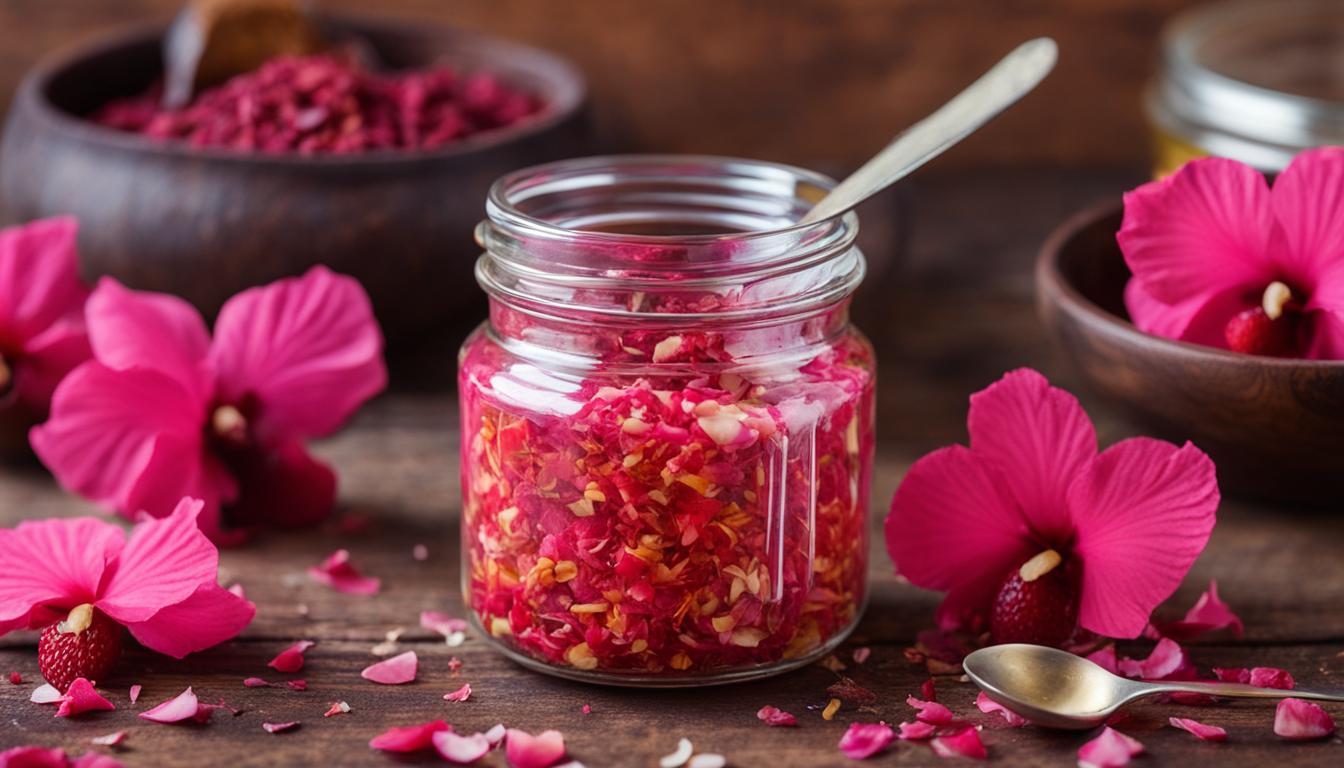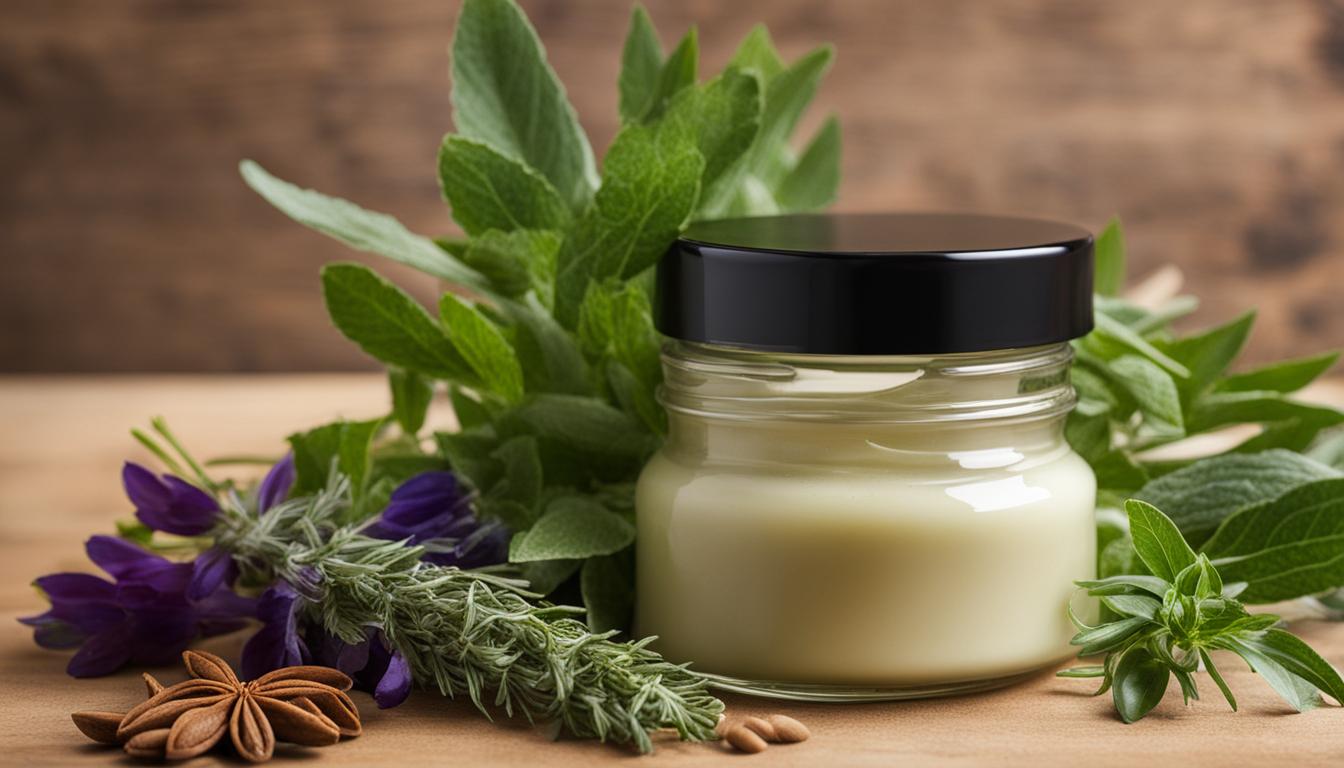Sunscreen is an essential product for protecting our skin from the harmful effects of UV rays. While there are many commercially available options, making your own sunscreen at home can be a cost-effective and safe alternative. In this article, I will guide you through the basics of sunscreen and share DIY recipes using natural ingredients, allowing you to create your own sunscreen right in your kitchen.
Key Takeaways:
- Learn how to make sunscreen with natural ingredients at home
- Discover a homemade sunscreen recipe using natural ingredients
- Understand the importance of SPF and broad-spectrum protection
- Explore the limitations of homemade sunscreen
- Consider alternative sunscreen options and common-sense approaches to sun exposure
Understanding Sunscreen Effectiveness
To understand what makes a sunscreen effective, it’s essential to know the terms used to describe it. SPF (sun protection factor) is a numerical estimate of how well a product protects against UVB rays. The American Academy of Dermatologists recommends using an SPF of at least 30. Broad-spectrum sunscreens protect against both UVB and UVA rays. Sunblocks sit on top of the skin and physically block UV rays. Chemical sun protection filters are ingredients regulated by the FDA and used in most sunscreens. Natural sunscreens typically use minerals like titanium dioxide or zinc oxide to reflect UV rays.
When choosing a sunscreen, it’s important to consider its effectiveness in providing protection against harmful UV rays. The SPF level and whether it offers broad-spectrum coverage are crucial factors to consider. Here’s a breakdown of these terms:
- SPF level: SPF measures the level of protection against UVB rays, which are responsible for sunburn. An SPF of 30 or higher is recommended by dermatologists as it offers significant protection.
- Broad spectrum: Sunscreens labeled as “broad spectrum” provide protection against both UVB and UVA rays. UVA rays penetrate deeper into the skin and contribute to premature aging and skin cancer.
- Sunblock: Sunblocks, also known as physical sunscreens, contain ingredients like zinc oxide or titanium dioxide that sit on top of the skin and reflect UV rays. They provide immediate protection upon application.
- Chemical sun protection filters: These are ingredients regulated by the FDA and are commonly used in sunscreen formulations. They work by absorbing and dispersing UV rays, converting them into heat.
- Natural sunscreen: Natural sunscreens utilize mineral-based filters like zinc oxide or titanium dioxide to protect the skin from UV rays. They are often preferred by individuals looking for alternatives to chemical filters.
Familiarizing yourself with these terms will help you make informed choices when selecting a sunscreen that suits your needs. Whether you opt for a chemical or natural sunscreen, ensure it has an adequate SPF level and offers broad-spectrum protection to shield your skin from the sun’s harmful rays.
The Limitations of Homemade Sunscreen
While homemade sunscreen recipes found on the internet may seem like a natural and cost-effective solution for sun protection, it’s important to understand their limitations. These homemade recipes may not provide adequate protection against the harmful UVB and UVA rays that can cause skin cancer.
Although certain ingredients like red raspberry seed oil and aloe vera may offer some level of natural UV protection, they lack the powerful UV filters found in commercially available sunscreens. These filters, such as titanium dioxide or zinc oxide, are necessary to effectively block harmful rays and reduce the risk of skin damage.
The Food and Drug Administration (FDA) has set requirements for sunscreen products to ensure their safety and efficacy. These requirements mandate the inclusion of specific UV filters, like titanium dioxide or zinc oxide, in order for a sunscreen to be considered safe and effective.
It’s important to note that homemade sunscreen recipes do not undergo the same rigorous testing and regulation as commercially available sunscreens. Therefore, their effectiveness and level of sun protection may not be reliable. To ensure adequate sun protection, it’s recommended to choose sunscreen products that meet FDA requirements and are backed by scientific research.
Common DIY Sunscreen Myths
- Myth 1: Homemade sunscreen is just as effective as store-bought sunscreen.
- Myth 2: Natural ingredients like coconut oil and shea butter provide sufficient sun protection.
- Myth 3: Homemade sunscreen is safer and chemical-free.
It’s crucial to understand that these myths are not supported by scientific evidence. While natural ingredients may offer some benefits, they alone cannot provide the same level of protection as commercially available sunscreens that comply with FDA requirements.
According to the American Academy of Dermatology, homemade sunscreens should not be considered a substitute for professionally formulated sunscreen. It’s important to use sunscreen products that have been tested and proven to be safe and effective against harmful UV rays.
So, while making your own sunscreen at home may seem appealing, it’s important to prioritize your skin’s health and safety by opting for professional-grade sun protection.
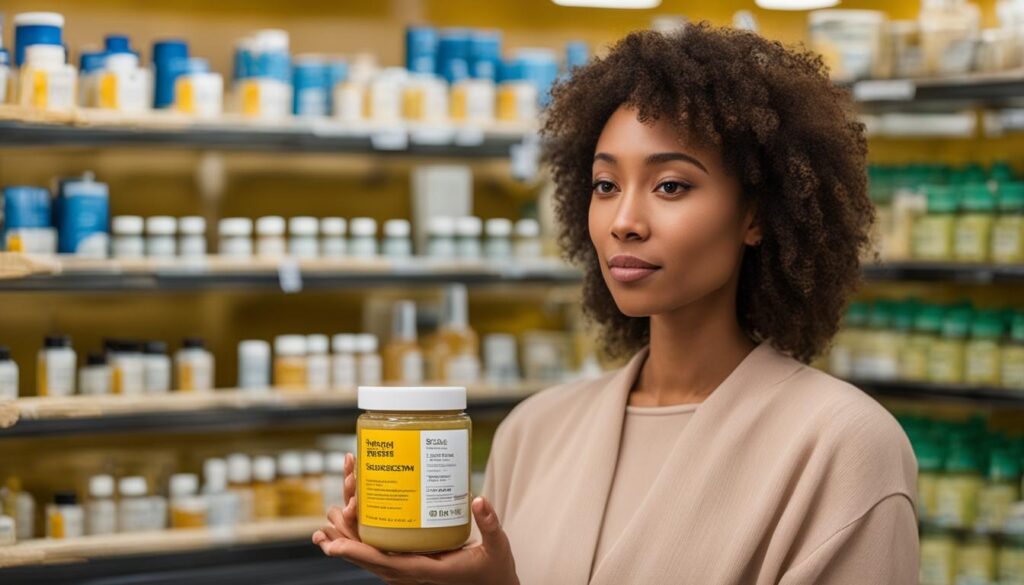
The FDA’s Requirements for Sunscreen
The Food and Drug Administration constantly updates its guidelines to promote safer and more effective sunscreen options. The latest requirements call for the inclusion of specific UV filters, such as titanium dioxide or zinc oxide, in order to be considered safe and effective.
These requirements ensure that sunscreens provide broad-spectrum protection against both UVB and UVA rays, reducing the risk of sunburn, skin aging, and skin cancer. By adhering to FDA requirements, manufacturers ensure that their products have undergone testing and meet specific standards for sun protection.
When choosing sunscreen, it’s advisable to look for products that comply with FDA regulations to ensure you’re getting the best possible protection for your skin.
Homemade Sunscreen Recipe with Aloe Vera and Coconut Oil
Creating your own homemade sunscreen can be a fun and cost-effective way to protect your skin from the harmful effects of the sun. One popular recipe combines natural ingredients like coconut oil, powdered zinc oxide, pure aloe vera gel, walnut extract oil, and shea butter to create a homemade sunscreen lotion. Another variation of this recipe involves making a DIY sunscreen spray by adding aloe vera gel and a carrier oil like almond oil to the main ingredients. Both of these homemade sunscreen options provide protection against UVA and UVB rays.
It’s important to note that homemade sunscreen may have a lower SPF compared to commercially available sunscreens, so it’s crucial to reapply it regularly, especially after swimming or sweating. Additionally, keep in mind that homemade sunscreens may not provide the same level of water resistance as store-bought options.
“Creating your own homemade sunscreen allows you to control the ingredients and tailor the product to your specific needs. However, it’s important to understand the limitations and ensure you’re taking proper precautions to protect your skin.”
Below is a step-by-step guide for creating your own homemade sunscreen lotion:
- In a microwave-safe bowl, melt 1/4 cup of coconut oil and 1/4 cup of shea butter.
- Add 2 tablespoons of powdered zinc oxide, 2 tablespoons of pure aloe vera gel, and 1 tablespoon of walnut extract oil to the melted mixture.
- Stir well to combine all the ingredients thoroughly.
- Pour the mixture into a container or small bottles for easy application.
- Store the homemade sunscreen lotion in a cool, dry place away from direct sunlight.
And here is a simple recipe for a homemade sunscreen spray:
- In a spray bottle, combine 1/4 cup of coconut oil, 2 tablespoons of powdered zinc oxide, 2 tablespoons of pure aloe vera gel, and 1 tablespoon of almond oil.
- Shake well to ensure all the ingredients are mixed properly.
- Keep the homemade sunscreen spray in a cool, dry place for storage.
Remember to shake the sunscreen spray before each use to ensure even distribution of the ingredients.
Keep in mind that these recipes may not have the same SPF level as commercial sunscreens, so it’s important to assess your individual sun protection needs and consult with a healthcare professional if needed. Always perform a patch test on a small area of your skin to check for any allergic reactions before applying the homemade sunscreen to your entire body.

It’s crucial to reapply the homemade sunscreen lotion or spray regularly, especially after swimming, sweating, or prolonged sun exposure. By taking the necessary precautions, you can enjoy the benefits of homemade sunscreen while protecting your skin from the harmful effects of the sun.
Homemade Sunscreen for Oily Skin
People with oily skin often struggle to find a suitable sunscreen that doesn’t make their skin feel greasy. Fortunately, there are homemade alternatives to traditional sunscreen recipes that are specifically tailored for oily skin. By using the right carrier oils and making a few ingredient swaps, you can create a homemade sunscreen that provides sun protection without exacerbating oiliness.
The Benefits of Carrier Oils for Oily Skin
When it comes to formulating a homemade sunscreen for oily skin, it’s important to choose carrier oils that are lightweight and non-comedogenic. Jojoba oil and sweet almond oil are excellent choices as they have a low comedogenic rating, meaning they are less likely to clog pores and cause breakouts. These carrier oils also help regulate sebum production, preventing excessive oiliness without stripping the skin of its natural moisture.
If you prefer a scented sunscreen, you can enhance the formula by adding essential oils that have sebum-regulating properties. Peppermint and lavender essential oils are known for their ability to balance oil production, making them ideal additions to a homemade sunscreen for oily skin.
I have found that swapping out coconut oil for jojoba oil in my homemade sunscreen has made a noticeable difference in controlling the oiliness on my skin. The lightweight texture of jojoba oil is perfect for reducing shine while providing sun protection. I also love the refreshing scent that peppermint essential oil adds to my homemade sunscreen. It’s a winning combination for my oily skin!
Alternative Ingredients to Coconut Oil
| Traditional Ingredient | Alternative Ingredient |
|---|---|
| Coconut oil | Jojoba oil or sweet almond oil |
While coconut oil is a popular ingredient in many DIY sunscreen recipes, it can feel heavy on oily skin and potentially worsen the shine throughout the day. By using jojoba oil or sweet almond oil instead, you can achieve a lightweight and non-greasy homemade sunscreen that is better suited for oily skin.

Creating your own homemade sunscreen for oily skin allows you to have control over the ingredients and tailor them to your specific needs. By utilizing carrier oils like jojoba oil or sweet almond oil and incorporating sebum-regulating essential oils, you can achieve a sunscreen that not only provides protection but also helps manage oiliness. Say goodbye to greasy sunscreen and hello to a homemade solution that keeps your skin protected and shine-free!
Homemade Waterproof Sunscreen
While some recipes claim to be waterproof, it’s important to note that homemade sunscreens may not have the same water resistance as commercially available products. Waterproofing ingredients found in commercial sunscreens are highly processed and difficult to replicate in homemade recipes. It’s always recommended to reapply sunscreen after sweating or swimming, regardless of whether it’s homemade or store-bought.
Limitations of Homemade Waterproof Sunscreen
Creating a truly waterproof sunscreen at home poses challenges. Homemade recipes typically lack the specialized ingredients used in commercial sunscreens to provide long-lasting water resistance. These ingredients undergo extensive testing and processing to ensure their effectiveness.
“Homemade sunscreens, although they may offer some level of protection, do not provide the same water resistance as their commercially available counterparts. The highly processed waterproofing agents found in store-bought sunscreens are difficult to replicate with natural ingredients.”
To ensure adequate protection while enjoying water activities, it is advisable to use a commercially available waterproof sunscreen. These products have been scientifically formulated and tested to withstand prolonged exposure to water and maintain their efficacy.
Though homemade sunscreens may provide some level of protection, their water resistance may not be sufficient for activities such as swimming, water sports, or excessive sweating. It is crucial to prioritize your skin’s safety and invest in sunscreens specifically designed for water-resistant and waterproof protection.
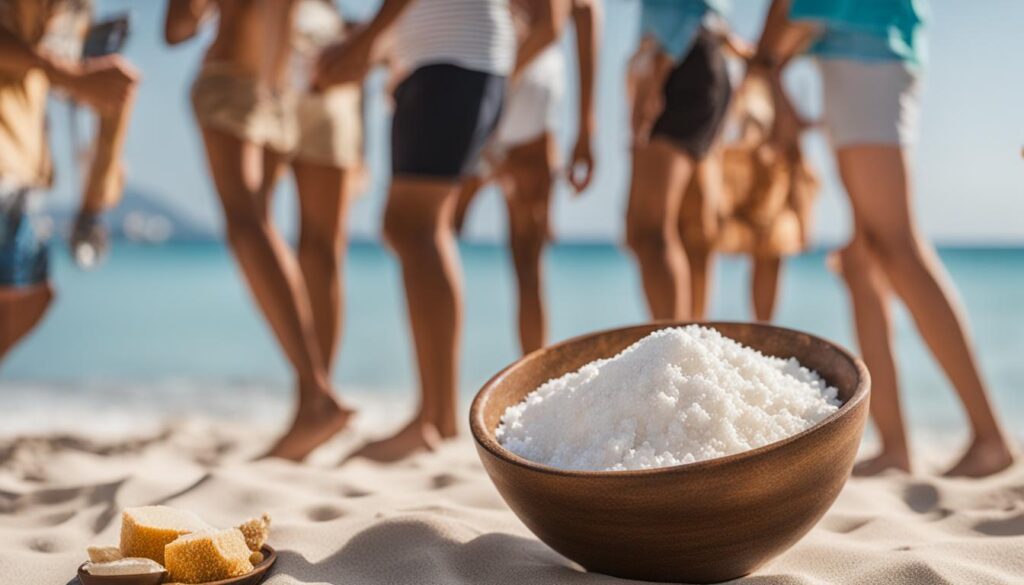
The Importance of Sunscreen
When it comes to protecting our skin from the harmful effects of the sun, sunscreen plays a critical role. By reducing the risk of sunburn and subsequent skin lesions, sunscreen helps prevent conditions like melanoma. While there may be concerns about certain ingredients found in commercial sunscreens, it is still essential to safeguard our skin from the damaging effects of UV rays.
Using a sunscreen with a broad-spectrum SPF is crucial for optimal sun protection. SPF (Sun Protection Factor) determines how well a sunscreen shields the skin from UVB rays, which cause sunburn. Choosing a sunscreen with a higher SPF, such as SPF 30 or above, offers better protection against the sun’s harmful rays. Additionally, broad-spectrum sunscreen protects against both UVB and UVA rays, which can cause long-term skin damage and increase the risk of skin cancer.
Seeking shade and wearing sun-protective clothing are additional sun protection measures that should be followed alongside using sunscreen. When UV rays are the strongest, typically between 10 a.m. and 4 p.m., staying in the shade can significantly reduce exposure. Sun-protective clothing that covers the skin, such as hats, sunglasses, and long-sleeved shirts, further minimizes UV radiation and decreases the risk of sunburn and skin damage.
Limiting sun exposure is also integral to maintaining skin health. While sunlight is necessary for vitamin D synthesis, excessive exposure can lead to harmful effects. Finding a balance between obtaining the required vitamin D and protecting the skin from excessive UV radiation is essential. For those at higher risk of vitamin D deficiency, alternative sources such as dietary supplements or specific dietary choices can help maintain optimal vitamin D levels.
Overall, sunscreen is a vital component of sun protection. By including it in our daily skincare routine, along with seeking shade, wearing protective clothing, and limiting sun exposure, we can reduce the risk of sunburn and minimize the chances of developing melanoma and related skin conditions.

| Benefits of Sunscreen |
|---|
| Reduces the risk of sunburn |
| Prevents skin damage and premature aging |
| Decreases the chances of developing melanoma |
| Protects against both UVB and UVA rays |
| Essential for maintaining healthy skin |
The Limitations of Homemade Sunscreen
Creating a safe and effective sunscreen at home is a challenging task that requires expertise and resources typically available to professionals. The development of sunscreen involves extensive research and testing to ensure its ability to provide proper protection from harmful UV rays. While homemade sunscreens can offer some level of sun protection, they may not match the effectiveness of commercially available products.
When formulating sunscreen, professionals have access to a wide range of ingredients and advanced technologies that allow for the creation of high-performing products. They can carefully select and combine specific UV filters, antioxidants, and other active ingredients to achieve optimal sun protection. The difficulty of replicating this level of effectiveness and reliability in homemade recipes is a significant limitation.
“Creating a safe and effective sunscreen requires expertise, resources, and rigorous testing, ensuring its ability to provide proper protection from harmful UV rays. Professionals have access to a wide range of ingredients and advanced technologies.”
Furthermore, commercial sunscreens undergo rigorous testing to determine their SPF (sun protection factor) and ensure they provide broad-spectrum protection against both UVB and UVA rays. The testing process involves evaluating factors such as photostability, water resistance, and skin compatibility. Homemade sunscreens generally lack this level of testing and may not offer reliable and consistent protection.
It’s important to understand that the limitations of homemade sunscreen do not dismiss the value of protecting your skin from the sun’s harmful rays. While homemade options can provide some sun protection, they may not meet your specific needs or offer the same level of effectiveness as professional-grade sunscreens.
To ensure adequate sun protection, it is recommended to choose a sunscreen option that meets your individual needs, consult with a dermatologist, and consider professional-grade sun protection products that have undergone rigorous testing.
Alternative Sunscreen Options
If you’re concerned about the ingredients in commercial sunscreens, there are alternative options available. One popular choice is oxybenzone-free sunscreens, which have gained attention due to concerns about hormone disruption and coral reef damage. This ingredient has been found to have potential negative effects on the environment and human health.
The FDA has taken steps to address these concerns and promote safer sunscreen options. They have updated their guidelines to recommend the use of alternative ingredients, such as titanium dioxide or zinc oxide, which have been proven effective in providing sun protection without the potential harmful effects.
Natural sunscreen trends have also gained traction in recent years. These products use ingredients derived from nature, such as plant extracts and essential oils, to provide protection against UV rays. Many people prefer natural sunscreens as they believe they are gentler on the skin and less likely to cause irritation or allergic reactions.
To find alternative sunscreen options, you can explore the market for oxybenzone-free sunscreens or consult with dermatologists who specialize in natural skincare. They can provide recommendations based on your specific needs and concerns.
Comparison of Oxybenzone-free and Natural Sunscreens
| Oxybenzone-free Sunscreens | Natural Sunscreens | |
|---|---|---|
| Main Ingredients | Chemical filters other than oxybenzone, such as titanium dioxide or zinc oxide | Natural ingredients like plant extracts, essential oils, and minerals |
| Effectiveness | Proven effective in providing sun protection | Vary in effectiveness, with some offering broad-spectrum protection |
| Potential Side Effects | Less likely to cause irritation or allergic reactions compared to conventional sunscreens | Possible irritations or allergic reactions for individuals sensitive to certain plant extracts or oils |
| Sustainability | May still have environmental impact due to other chemical filters used | Safer for the environment, with fewer harmful chemicals |
While both oxybenzone-free and natural sunscreens offer alternatives to traditional sunscreens, it’s essential to consider your personal preferences and skin sensitivities when choosing the right option for you. Consulting with a healthcare professional or dermatologist can provide valuable insights and guidance in selecting the most suitable alternative sunscreen.

Balancing Sun Protection and Vitamin D Absorption
While it’s crucial to prioritize protecting our skin from excessive sun exposure, we must also consider the role sunlight plays in vitamin D synthesis. Vitamin D is an essential nutrient for various bodily functions, and our bodies need sunlight to produce it. Striking a balance between sun protection and vitamin D absorption is vital for maintaining overall health and well-being.
Excessive sun exposure, especially without adequate protection, can increase the risk of skin damage, including sunburn, premature aging, and an increased risk of skin cancer. However, avoiding the sun altogether can lead to vitamin D deficiency, which can have negative effects on bone health, immune function, and other essential bodily processes.
A key factor in finding this balance lies in understanding our individual needs. Some individuals may have a higher risk of vitamin D deficiency due to factors such as location, lifestyle, and skin type. For these individuals, alternative sources of vitamin D, such as dietary supplements or specific dietary choices, can help maintain optimal levels.
When it comes to sun protection, there are several strategies for balancing sun exposure and vitamin D absorption:
- Be mindful of the time spent in the sun: Avoid prolonged exposure during peak UV hours, especially between 10 am and 4 pm when the sun’s rays are strongest.
- Seek shade: When outdoors, seek shade under trees, umbrellas, or other protective structures to reduce direct sun exposure.
- Wear protective clothing: Covering exposed skin with hats, long sleeves, and pants can provide an extra layer of defense against UV rays.
- Apply sunscreen: Use a broad-spectrum sunscreen with a minimum SPF of 30 to protect exposed skin. Remember to reapply every two hours or after sweating or swimming.
- Follow a healthy diet: Incorporate foods rich in vitamin D, such as fatty fish, fortified dairy products, and egg yolks, to support your body’s vitamin D levels.
It’s important to note that finding the right balance between sun protection and vitamin D absorption may require individual adjustments. Consulting with a healthcare professional or dermatologist can provide personalized guidance based on your specific needs and circumstances.
“Finding a balance between protecting your skin and getting enough vitamin D is essential for maintaining overall health and well-being.”
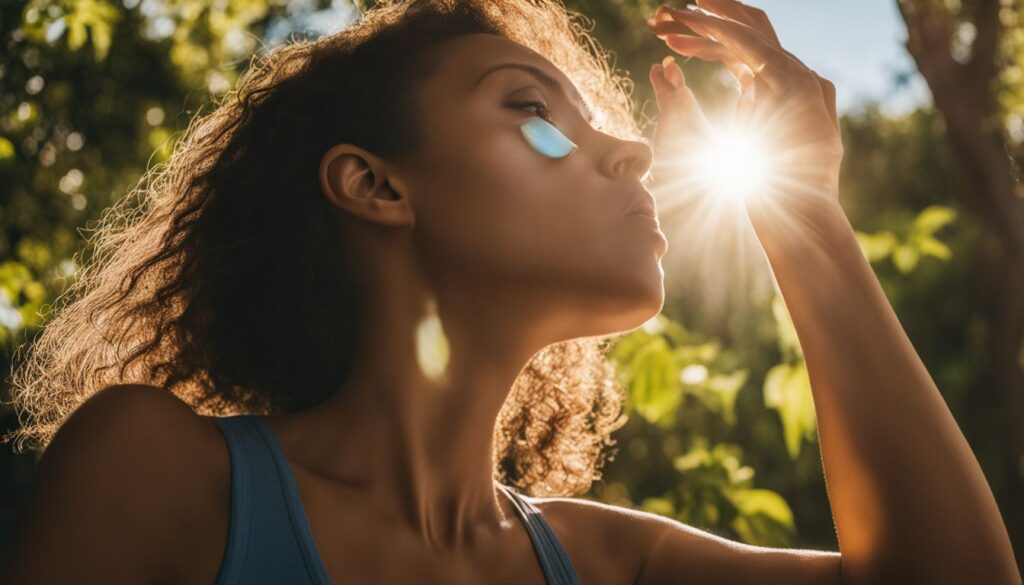
By following these common-sense approaches to sun exposure and considering individual needs, you can strike the ideal balance between protecting your skin from the sun’s harmful rays and ensuring adequate vitamin D absorption. Remember, taking care of your skin and overall health is a lifelong commitment.
Common-Sense Approaches to Sun Exposure
To enjoy the benefits of the sun while minimizing the risks, adopting common-sense approaches to sun exposure is recommended. These strategies include:
- Spending time outside during morning or evening hours when the sun’s rays are less intense.
- Seeking shade when the sun is at its strongest, usually between 10 a.m. and 4 p.m.
- Wearing wide-brimmed hats and clothing with built-in SPF for added protection.
- Applying sunscreen with a broad-spectrum SPF of at least 30 on all exposed skin, including the face, neck, and ears.
- Supporting skin health from the inside by consuming a diet rich in antioxidants, vitamins, and minerals, and staying hydrated.
By following these sun protection strategies, you can still enjoy outdoor activities while safeguarding your skin against harmful UV radiation.
| Common-Sense Approaches to Sun Exposure | Sun Protection Strategies |
|---|---|
| Spending time outside during morning or evening hours | When the sun’s rays are less intense |
| Seeking shade | Between 10 a.m. and 4 p.m. |
| Wearing wide-brimmed hats and SPF clothing | For added protection |
| Applying sunscreen with SPF 30 or higher | On all exposed skin |
| Supporting skin health from the inside | Through proper nutrition and hydration |
Conclusion
In conclusion, homemade sunscreen can be a viable option for individuals who have concerns about certain ingredients commonly found in commercial products. It allows them to have more control over the ingredients they use on their skin. However, it’s important to be aware of the limitations of homemade sunscreen and the need for professional-grade sun protection.
When making informed decisions about sun protection, it is crucial to consider the factors of effectiveness, safety, and convenience. Homemade sunscreen may not provide the same level of protection as commercially available options that have undergone extensive research and testing. To ensure optimal sun protection, it is advisable to consult with a healthcare professional or dermatologist who can provide personalized advice based on individual skin type, lifestyle, and sun exposure habits.
Remember that protecting your skin from the harmful effects of UV rays is essential for maintaining skin health and reducing the risk of sunburn and skin cancer. Whether you choose to use homemade or commercial sunscreen, always prioritize SPF, broad-spectrum protection, and regular application. By making informed decisions and taking necessary precautions, you can enjoy the benefits of the sun while keeping your skin safe.
FAQ
How can I make sunscreen at home using natural ingredients?
To make sunscreen at home using natural ingredients, you can try recipes that involve the use of ingredients like coconut oil, powdered zinc oxide, pure aloe vera gel, walnut extract oil, and shea butter. These ingredients are combined and mixed to create a homemade sunscreen lotion or spray. However, it’s important to note that homemade sunscreens may not offer the same level of protection as commercially available products, so caution should be exercised.
Are homemade sunscreens as effective as store-bought ones?
Homemade sunscreens may not provide the same level of protection as store-bought ones. While natural ingredients like coconut oil and aloe vera may offer some UV protection, they lack the powerful UV filters found in commercially available sunscreens. The FDA recommends the use of specific ingredients like titanium dioxide or zinc oxide to ensure safety and effectiveness in sunscreens. It’s important to choose a sunscreen option that meets your needs and consult with a dermatologist if you have any concerns.
Can homemade sunscreens be waterproof?
Homemade sunscreens may not have the same water resistance as commercially available products. The waterproofing ingredients found in commercial sunscreens are highly processed and difficult to replicate in homemade recipes. It’s always recommended to reapply sunscreen after sweating or swimming, regardless of whether it’s homemade or store-bought, to ensure ongoing protection.
Why is sunscreen important?
Sunscreen is important because it helps protect the skin from the harmful effects of UV rays. UV rays can cause sunburn, premature aging, and increase the risk of skin cancer. Using a sunscreen with a broad-spectrum SPF, seeking shade, wearing sun-protective clothing, and limiting sun exposure are all essential components of sun protection.
Are there alternative sunscreen options available?
If you’re concerned about certain ingredients in commercial sunscreens, there are alternative options available. Look for oxybenzone-free sunscreens, as this ingredient has raised concerns about hormone disruption and coral reef damage. The FDA has updated its guidelines to promote safer sunscreen options. Natural products and wellness trends have led to the development of better sunscreen choices, which can be found on the market or recommended by dermatologists.
How can I balance sun protection and vitamin D absorption?
While it’s important to protect the skin from excessive sun exposure, it’s also important to consider the role of sunlight in vitamin D synthesis. Our bodies need sunlight to produce vitamin D, an essential nutrient for various bodily functions. Finding a balance between sun protection and vitamin D absorption is crucial. It’s recommended to spend time outside during morning or evening hours when the sun’s rays are less intense, seek shade, wear hats and SPF clothing, apply sunscreen as needed, and support skin health from the inside through proper nutrition and hydration.
What are some common-sense approaches to sun exposure?
Common-sense approaches to sun exposure include spending time outside during morning or evening hours when the sun’s rays are less intense, seeking shade, wearing hats and SPF clothing, applying sunscreen as needed, and supporting skin health from the inside through proper nutrition and hydration. These strategies can help reduce the risk of sunburn and skin damage while still enjoying the benefits of the sun.
Can homemade sunscreen be a viable option?
While homemade sunscreen can be a viable option for some individuals, it’s important to understand the limitations. Creating a safe and effective sunscreen at home is challenging without the expertise and resources available to professionals. Sunscreen development requires extensive research and testing to ensure proper protection from UV rays. While homemade options can provide some level of sun protection, they may not match the effectiveness of commercially available products. It’s recommended to choose a sunscreen option that meets your needs and consult with a healthcare professional or dermatologist for personalized advice on sun protection and skincare.



